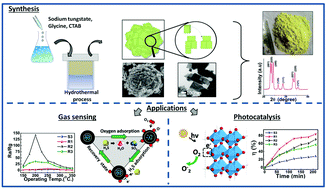Ru-Loaded mesoporous WO3 microflowers for dual applications: enhanced H2S sensing and sunlight-driven photocatalysis†
Abstract
We report a facile synthesis of Ru-loaded WO3 marigold structures through a hydrothermal route and their bidirectional applications as enhanced H2S gas sensors and efficient sunlight-driven photocatalysts. The developed hierarchical marigold structures provide effective gas diffusion channels via a well-aligned mesoporous framework, resulting in remarkable enhancement in the sensing response to H2S. The temperature and gas concentration dependence on the sensing properties reveals that Ru loading not only improves the sensing response, but also lowers the operating temperature of the sensor from 275 to 200 °C. The 0.5 wt% Ru-loaded WO3 shows selective response towards H2S, which is 45 times higher (142) than that of pristine WO3 (3.16) sensor, whereas the 0.25 wt% Ru-loaded WO3 exhibits the highest photocatalytic activity, as shown by the degradation of rhodamine B (RhB) under natural sunlight. The gas sensing and photocatalytic properties are explained through the role of Ru and the structural and morphological properties of the developed material.



 Please wait while we load your content...
Please wait while we load your content...